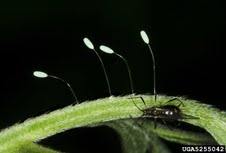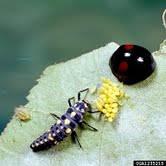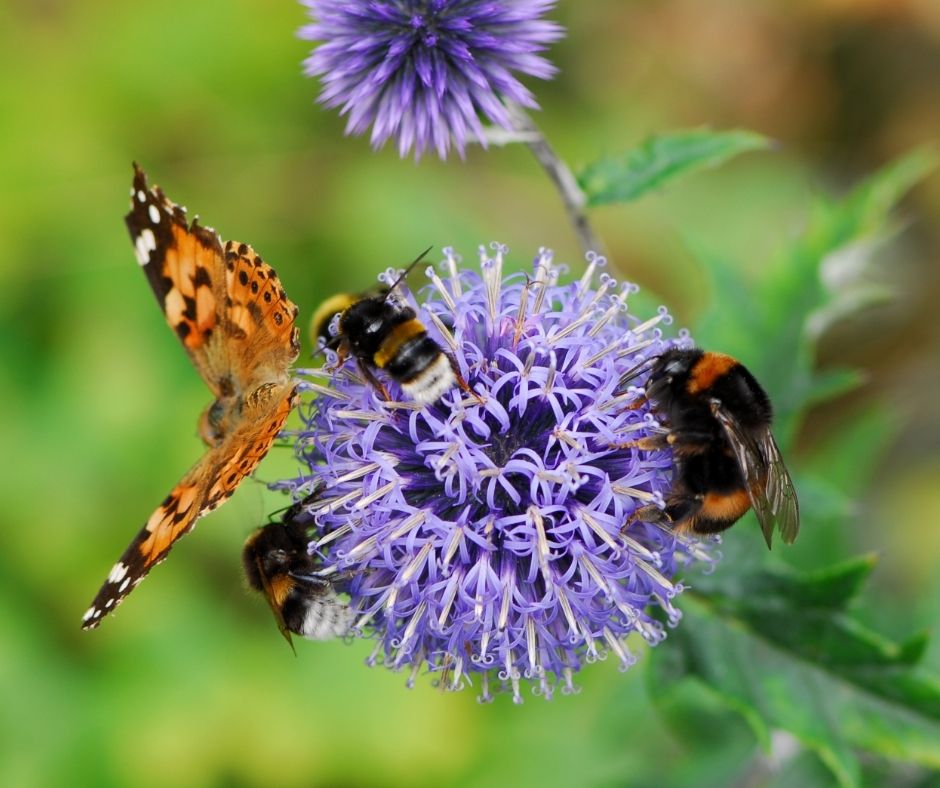by Nicole Sanchez, NC Cooperative Extension
Did you know that about a million species of insects have been identified worldwide, but that only about 5% of them qualify as pests of humans? As is often the case in other, non-insect circles, “bad guys” get all the press. And not entirely without reason – remember bubonic plague, the disease that killed a third of Europe’s population in the 1400’s? It was transmitted by the lowly flea. Malaria, still a concern in most developing countries, is carried by certain mosquitoes.

Lacewing – Photo Courtesy of Bugwood.org
But how much do you know about lacewings, the predaceous larvae of which resemble tiny alligators hatched from small white eggs atop long, gossamer stalks on the backs of leaves? Have you met the big-eyed bug, a once common resident of cotton fields, which eats at least 67 species of other insects, but takes only shelter and a little moisture from your plants? How about the twice-stabbed lady beetle, a smaller, lesser-known cousin of our red-with-black-spots-ladies? More than an opportunity for entomologists to express a sense of humor while naming insects, this black–with-two red-spots ladybeetle
is a voracious eater of aphids and scales in trees and has demonstrated effective control of elongated hemlock scale, a problematic introduced pest.

Bigeyed Bug – Photo Courtesy of Bugwood.org
Welcome to the other 95%! Perhaps you were already aware of the benefits provided by our more famous beneficial insects, like honeybees and butterflies. Perhaps you were already aware that pollinators also come in beetle and fly form. Perhaps, you have at some point noticed a rove beetle or carrion beetle and appreciated that it serves the same function, on a smaller scale, that vultures do on the roadside. Or do you focus only on the 5%?
A lifelong student of horticulture, my first foray into the world of pure botany illustrates an important point when it comes to insects. Roaming the campus on a plant ID walk, my professor noticed that I was saying the Latin names of many of the plants to myself as he named them. He pointed to a broadleaf herbaceous something and asked me what it was. “Sorry,” I said, “I know a lot of ornamentals. But I don’t know weeds.” I don’t remember what plant he asked me to ID, but I clearly remember his response: “ Over on this campus, young lady, we refer to those as native plants. It’s only a weed on the Ag campus.”

Twice-Stabbed Beetle – Photo Courtesy of Bugwood.org
Ever since, I have been careful to label plants as weeds only when they are so located as to be “troublesome plants out of place”, as per definition. Similarly, “pest” is a label often applied unfairly to our insect friends. Fast forward five years to when I was the director of a well-known butterfly conservatory, taking a call from a frustrated would-be butterfly gardener. “I’ve planted every plant the books say I should”, she said. “I’m doing everything correctly. But I can’t seem to grow a butterfly garden because these (explicative) caterpillars keep eating up all the plants!”
Was the pest the caterpillars, or the caller who did not know her insect friends well enough to recognize them in their juvenile stage?
The world of our insect friends, once discovered, is fascinating, educational, perspective-changing, and at your fingertips. To see fantastic images of your insect friends (and those not so friendly to human enterprises), spend some time on the amazing website Bugwood, where you will find insect images by category. Hint – your insect friends include, but are not limited to, predators, parasites, parasitoids, and pollinators. Don’t let the “bad guys” get all the attention!






